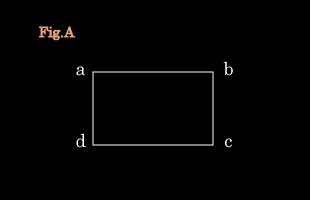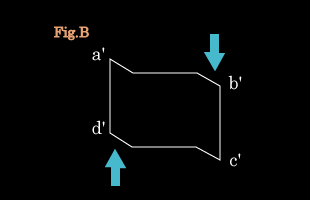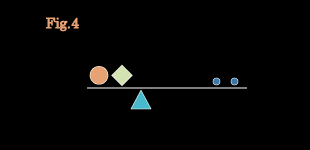 |
| Japanese pottery has its origins in the Jomon era, thousands of years ago. No one knows whether rules of form existed at that time or not. The pottery of each kiln and each era has had its own characteristics, but it is thought that styles of pottery have developed through adjustments by individuals in the process of being passed down from father to son or from master to disciple. |
 |
| There are no rules in a street fight beyond self-restraint, but there are rules for karate and judo and other sports, for traditional culture, and for all traditional arts. It is possible to enjoy sports or the arts to a certain extent without rules, but rules make them even more enjoyable. One never hears of spectators at a street fight, and it is said of some fights that "not even a dog will eat" them, meaning that no one likes them. From a certain point of view, dog fights and cock fights may be much like street fights, but there are still rules governing the way the fight is carried out and how to determine the winner. Most events or objects meant for observation or contemplation are subject to rules, and they give greater pleasure to viewers because of this. |
 |
| I have never given much consideration to rules in pottery, aside from certain conventions of old Karatsu appreciated by connoisseurs, such as mikazuki kodai ("crescent moon foot," foot thinner on one side than the other), chirimenjiwa ( "crepe wrinkles," wrinkled effect on clay surface caused by use of modeling tool near foot), and shirimakuri ("raised skirt," exposure of the surface where glaze is not applied at the base). However, Anjin Abe claims that there are definite rules that govern the making of Momoyama tea bowls. |
| Firing and Firing Effects |
| What did I find so amazing? The first thing that impressed me was the yakinari or firing effects. These are the effects created on the surface of the pots by firing. The quality of the surface texture depends on whether the clay is sufficiently fired, of course, but also on the variations and sense of depth in the exquisite and complex effects on the fired surface. I have mentioned the importance of the clay being completely fired. Clay that is not sufficiently fired, which is in a semi-raw condition, is fragile and breaks apart easily. It is common to see pots that are in this condition, and they are not very attractive. The variations and sense of depth, the exquisite and complex effects that I speak of are the changes that develop in the fired surface through repetitive firings. |
 |
| Abe describes ceramic as "low-purity iron." The surface of his pottery appears moist, but it also looks like iron. It is the kind of ceramic surface that is only seen in famous Bizen tea bowls made in the Momoyama and Keicho period. With respect to surface effects, Abe says, "Because people only want to fire one time, they do not understand." He explains that the Momoyama tea bowls described as masterpieces were placed in the kiln and fired over and over until the surface effects conceived in the original plan were achieved. They were fired four or five times, in some cases more than ten times. He says that it is only possible to understand when one sees the "effect of the fire." Of course, Abe also fires his work repeatedly until he obtains the surface effects he wants. |
 |
| In order to fire clay repeatedly, it is necessary to use clay that can withstand the firing methods being used. The clay most commonly used for Bizen ware nowadays has a low refractory level and is not suited to repeated firing. Certain methods of firing will produce profound, exquisite, and varied effects while other methods will produce effects that are more superficial, fainter, and less varied. |
 |
| For a long time, the surface effects of the old style of Bizen ware were thought to have developed over the last 400 years. However, Abe's ceramics have these old-style effects as soon as they emerge from the kiln. Abe says that they do not get better with time, speaking casually as if this were only natural. This was a great surprise to me. |
| The Extension of Force |
| Abe, as far as I understand him, has spoken about something he calls the "extension of force." If force is applied to one spot it extends continuously to other places. As Abe explains, "You might think of the way the force extends to an entire balloon when you push it in one place with your finger." One might also think about European sculpture, the work of Michelangelo, for example, in which the movement of the muscles is faithfully reproduced. If the posture of the body is moved just a little, it affects the muscles of the entire body. This contrasts with the form of Buddhist images in Japan. In a Miroku figure, for example, which has one hand raised and the other lowered, there would be no effect on other parts of the body if the positions of the hands were reversed. |
 |
| This extension of force can be explained with a diagram. If force is applied to the form in Fig. A, d moves to d' as shown in Fig. B, causing a to move to a'. If b is pushed to b', then c moves to c'. Although not shown here, the forces extended to a' and c' will continue to spread. |
 |
 |
| A shape like a beer bottle, formed around a single axis, might be stable but it lacks individuality and expressiveness. If we give it movement and add force (volume) to balance it, it gains in expressiveness and the ability to make a statement. What is referred to here as force is a point or line (not a conceptual point or line, but a physical point or line that can be seen with the eyes) or a length, thickness, width, or depth. When a certain linear force is applied on one side, a corresponding width, for example, is given to the other side, and balance is established with a sense of movement and variability. |
 |
| Abe's forms, when observed carefully, are always balanced with no places where volume could be transferred from the upper part to the lower part, from right to left, or from top to bottom. Whether seen from top or bottom, left or right, forces are balanced, and this creates a stable form that conveys a sense of calm to the viewer. |
| Three-Point Development |
| If a point is joined to another point, it makes a line. A tea bowl thrown symmetrically on the potter's wheel is formed with continuous lines. Two points make a line, and the addition of a third point creates a triangle that determines a plane. This can be visualized by thinking of the plastic triangles used in mechanical drawing. A line created by joining two points has no volume, but when it is incorporated in a plane it can take on volume in the form of width. A succession of triangular planes can form the outer surface of a solid, expressing force with volume in the planes and creating balance in varied ways. Abe's theory and his way of creating form depend on "three point development," which expresses the "extension of force" and "balance of force and volume" in successive triangular planes. This is what Abe calls the "Abe style."
This theory may be hard to understand, but it is possible to visualize how planes and solids can be expressed through a succession of triangles if you think of how a folded paper crane is formed by a series of triangular planes. |
 |
| Abe explains the style developed by Sen Rikyu and Furuta Oribe by saying that the potter's wheel only makes lines joining points but does not create planes. Rikyu and Oribe add one more point to make a plane. El Greco discovered a method of expression through triangles, added an additional point to two-dimensional space, and this method was further developed by Cezanne and Picasso. He suggests that this theory of "three-point development" was an important discovery that may have been brought to Japan from the West over the ocean during the age of exploration. He believes that the tea bowls made by Rikyu and Chojiro and the Oribe tea bowls made in the Momoyama and Keicho periods and some of the Bizen, Shigaraki, Iga, Shino, and Karatsu tea wares have the same roots and are based on the same theory of form. |
 |
| Balanced pieces made through the law of form known as "three-point development" and fired according to a certain firing plan are the same type of pottery as the "certain group of tea bowls made in the Momoyama and Keicho periods" referred to above. That is why they belong to a different realm than the contemporary ceramics made by pushing, pulling, and scraping. Of course, I do not mean to criticize this recent work. I simply want to say that pottery in what Abe calls the Rikyu-Oribe style belongs to a different dimension, a different world. Honami Koetsu was a representative maker of this type of ceramics and he was followed by Kitaoji Rosanjin in the modern period. The same style has been carried on through the present. |
| Final Result |
| Abe's kiln is an anagama, a through-draught kiln built completely underground. Once it is lit, there is nothing more that can be done. Until the fire is put out and the finished pots are taken from the kiln, no one knows what the result will be. Everything is left up to the fire. The form of the pots is determined one hundred percent by the will of the maker and the surface effects spoken of earlier can also be controlled to a large extent, but the final result cannot be known until the work emerges from the kiln. I once asked Abe about the yield, and he answered, "It is not a number that can be called a significant figure." |
 |
| Until quite recently, I thought that the typical ceramic pieces that one sees in books could be fired again at any time since they have already been fired once. However, I came to realize that this was a great mistake. As I have stated, Abe uses a plan for firing, a method for firing in an orderly fashion. However, it is difficult, even impossible, to control the effects of natural glazing in the kiln at temperatures above 1300 degrees where clay is changed to ceramic by firing. Even pieces with good firing effects may be returned to the kiln and fired again if the effects of natural glazing are not considered sufficient. A pot can be fired again if necessary, but the most common problem is an excess of natural glazing. In spite of this, the only way to obtain the finest pieces is to continue trying without fear of failure. |
 |
| An arrow shot at a target sixty meters away strikes at only one point, but it is extremely difficult to aim and hit a particular point. Considering the elements of the work that are created by processes beyond human power, it is truly amazing to encounter the sort of tea bowl that corresponds exactly to the aims of the potter. |
| Reasons |
| As I have written, there are reasons behind Abe's methods of forming and firing. Therefore, his methods can be explained. This does not mean that an explanation is sought or necessary, but its possibility means that an understanding of his work can be shared with others. Sometimes, a ceramic piece is described as good for "some reason or other." If pressed, it is hard to say what the reason is. It is difficult to explain the impression made by pieces produced according to sensual and emotional responses, and this obstructs the achievement of a shared awareness. Does that fact that Abe's work is based on reasons mean that it contains no emotion? I do not think so. It seems to me that Abe's approach is to envelop reason in emotion. It is difficult to identify the reasons behind Abe's work even if one is told that they exist. The reasons are difficult to understand, but I believe that emotion is what makes them hard to see. However, because the reasons are wrapped gently in emotion, it is easier for viewers to accept them unconsciously in their hearts and be able to look at the work with a sense of peace. |
 |
| As I said at the beginning, what first attracted me to Abe's Bizen ware was the surface texture, which could be mistaken for old Bizen. However, a person who understands Abe's theory of form and firing to some extent can respond to his work with the same sort of excitement and emotion felt by a person who has known nothing but the world beneath the clouds when he passes through them and sees the blue expanse of the sky. I realized that I did not think Abe's works were wonderful just because I realized they were his. It was the works themselves that made me feel this. It is a fact that they could only have appeared in this world through Abe's hand, but after they have arrived in the world, it is the works themselves, not who made them, that completely captures my interest. |





